Adebunmi Gbadebo is a multimedia artist who uses culturally and historically imbued materials to explore the connections between land, matter, and memory on sights of slavery. Born in New Jersey and based in Philadelphia, she is a multimedia artist, Yoruba priest, and documentarian. Gbadebo joined Lara Mashayekh in a conversation about family legacies, artistic techniques, and the materiality in her spiritual practice.
LXM: Your practice captures so many aspects of your ancestry and that of the Black American experience. I am curious about how you got invested in this work and where you acquired the archival materials embedded in your “history papers” series and silkscreens.
AG: I got invested in ancestry work around 2018 or 2019 as a student at SBA when my family was really committed to uncovering our history. Around then, I discovered that our family was enslaved on True Blue Plantation in South Carolina. I sought to abstractly capture that archival erasure and lost history by weaving strands of Black hair into abstracted “history papers” to capture that ancestry and encoded information. My family history is intertwined with the lives of many famous white people, including Richard Singleton, who owned True Blue Plantation and a neighboring one called Singleton Plantation. He had a very in-depth will, which included a key list of humans to pass down to his wife and children—many of whom were my relatives. Within the “history papers” series are silkscreens of wills and appraisal lists, including one that lists our ancestors alongside animals. There’s a violence in that, so there were a lot of mixed sentiments around how our family histories were emerging. We had to retain our perspective and divorce ourselves from the documents and the perceptions of the enslavers.


LXM: Wow, that’s powerful. How did you start working on Hear Me Now and what was your underlying inspiration?
AG: I was introduced by the MFA curator Michelle Fischer to the exhibition’s curatorial team [Ethan Lasser, Adrienne Spinozzi, and Jonathan Young], after Michelle attended a talk I led at The Clay Studio. I initially met the curators over Zoom, where they presented their research about the parallels between the Stony Bluff face vessels and traditional Kongolese minkisi ceramics. Based on our conversation, they gave me about nine months to make a series and ultimately selected two pieces for the show. In retrospect, I truly feel that Hear Me Now has become a way of teaching the next generation about our past and future. I am grateful for the way that they involved me as an artist on the project.
AG: Western or traditional practices of ceramic-making usually use coiling techniques. Coiling is a scratch-and-attach method, where you take a thin coil and score whatever you are building on, add liquid to attach the coil to the vessel, and smooth the seam. Yet, Nigerian coil techniques rely on thick coils and don’t use scratching. Instead, you add water to the inside of the vessel and churn the coil so it presses into the inner wall and cranks upwards. Rather than closing the seam by smoothing it out, you add another coil that falls into the seam and use a calabash or coconut pieces to smooth it over. Another major difference about this method—which I don’t always do—is that the vessel stays in one place on the ground, and the artist moves around it; this allows me to build instead of using a rotating device that keeps me stationary. I intend to go to Nigeria next year to learn from groups of women who are still maintaining this practice.
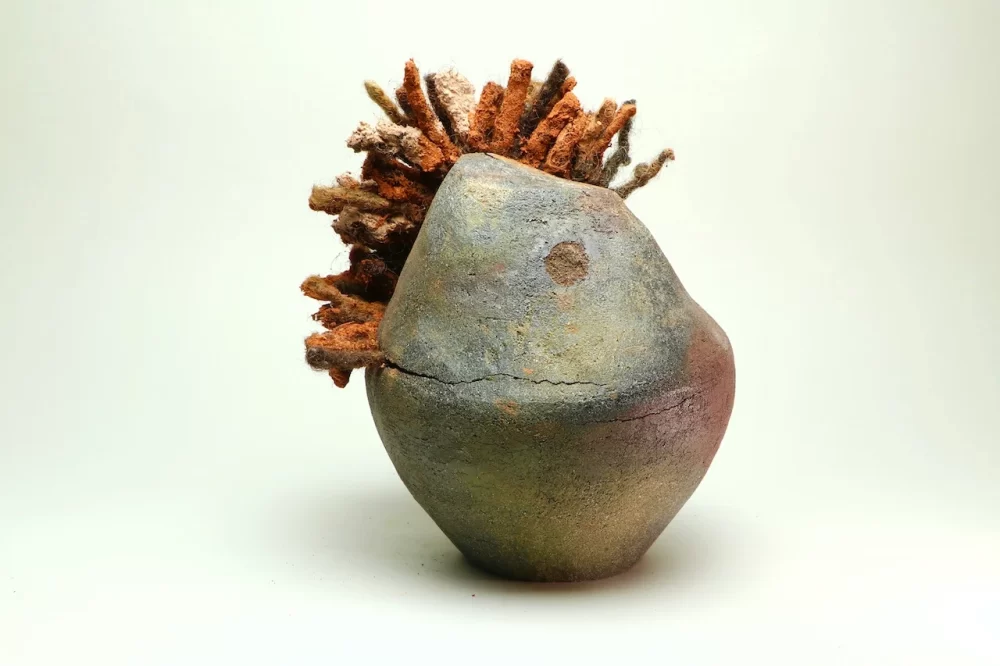
AG: Yes, I started using Black hair in art school as a junior at the School of Visual Arts. Paint has historically been used to construct narratives of whiteness, and it didn’t feel like a material that I wanted to continue. I felt that even if I grounded my paintings in Black subjectivity they would still be viewed through the prism of white history. Thus, my hair practice was completely enmeshed in Black subjectivity, life, politics, and spirituality. Initially, I would meet up with people at coffee shops, supermarkets, or parks for local hair donations. Other times, people would show up at my work and tell me elaborate stories about why they cut their hair. As the work has become more widely known, nowadays I receive my donations via mail, which has become a cool way of tracking who the person is, what city and state they’re from, the date it was sent, and my own location at a given time.
For my practice, I experimented with methods of sewing and weaving. I saw the needle as a paintbrush, especially when sewing hair into canvases and piercing through a surface that has traditionally held paint to insert my material. I used thread to bind or emphasize a lock, a kink, or a curl. While hair was foundational to my earlier practice, I now use it to enhance other materials I brought into my oeuvre, like cotton, indigo, and soil, based on materials that grew on the plantation. Cotton serves as a signifier of slavery. Yet, I take issue with the fact that the enslaver’s descendants are still benefiting from the land; they even started an LLC called True Blue Plantation LLC. These systems of power are still very much intact when you look at who still reaps the benefits of the land, products, and nomenclature of the spaces. When working with blue dyes and indigo, I certainly consider my position as a descendant of people forced to grow indigo, but also people who, before slavery, grew indigo for centuries. I certainly see myself working with the land in this present time and space. My body becomes a surrogate in the studio for continuing those traditions and channeling the histories that are within the materials.

LXM: Speaking of channeling, how have your Yoruba values and practices informed your artistic approach and helped you feel united with the material?
AG: Before I got initiated as a Yoruba priest, I remember having an epiphany as I was working with ceramics: I decided to use the earth from this cemetery and plantation as material. I also had the opportunity to create works for the Met’s Hear Me Now exhibition, which added a layer of pressure and excitement. I was becoming confident with my ability to coil build and to replicate a form as closely as possible in this new medium. Yet, I knew I had to create something of my own. In that unknown space, I remember wondering, “What am I going to make from this soil?” One day I paused on that question, and it hit me that 100 years ago, 200 years ago, 300 years ago—my ancestors didn’t have that decision. They could not decide for themselves what could come from this soil; they were just forced to grow cotton. The fact that all these years later, I sit here pondering about that question felt [long pause]—like my ultimate privilege that I could decide what came from that land. At that moment, it wasn’t just material. It is ancestral material; it has their bodies. It has their blood, their sweat. It has the everyday centuries of turning this soil over. It has all the cotton that is gone back into the ground. It has indigo. It has all the pine trees particular to that region that have witnessed what has happened on these plantations and shed their pine needles back into the land. All of that is encapsulated in this soil. In some ways, this was never a “new” material; it is probably one of the oldest materials I’ve connected to and know. The potential for form became the ultimate expression of my freedom, but also their sacrifice that I could decide what comes from that soil. I think that moment has guided how I approach the land.
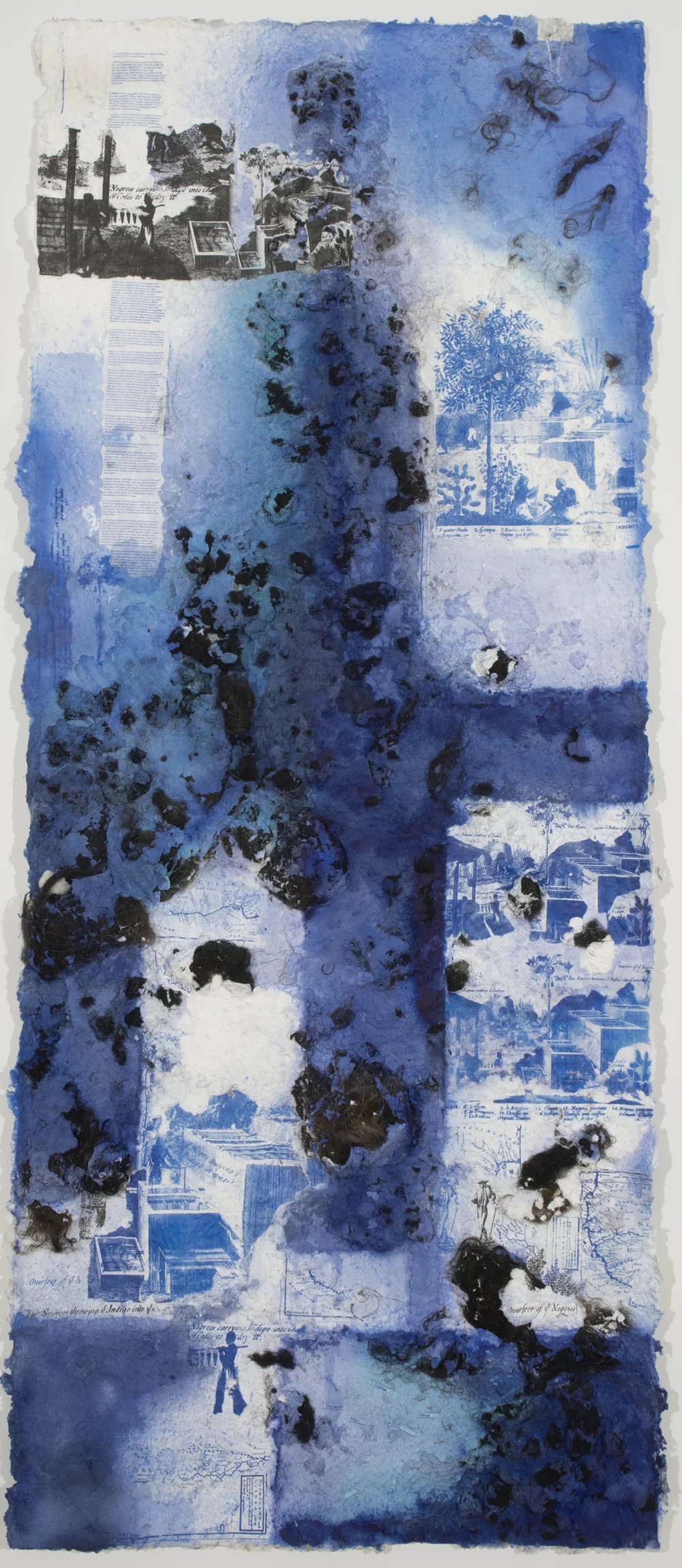
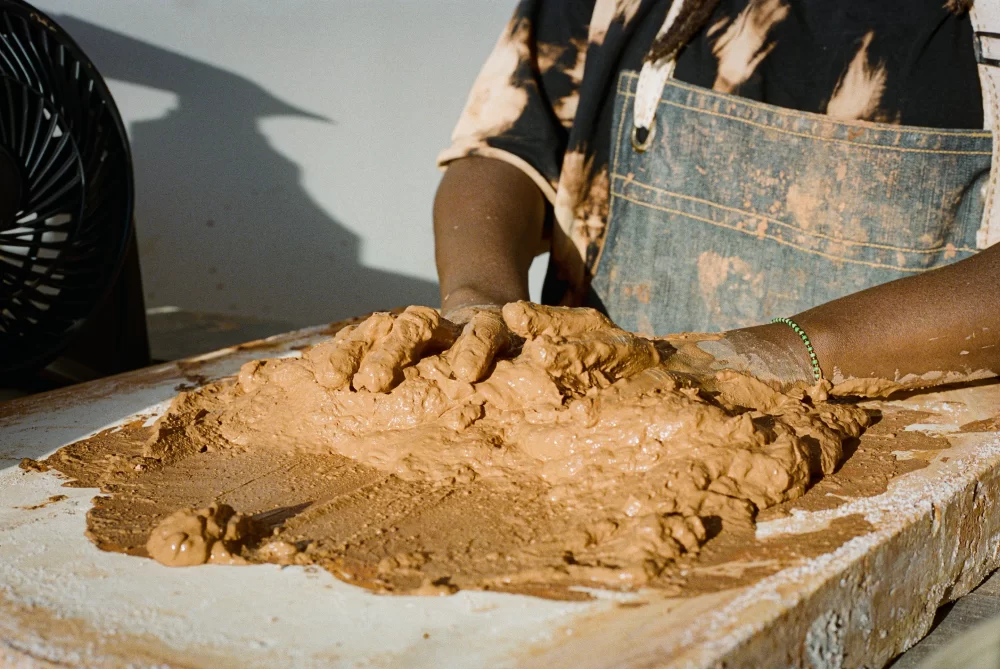
Since I have become an initiated Yoruba priest, I have a deeper connection and sense of the ancestry that lies within that ground. I also now feel a moral responsibility in my practice as a spiritual and ancestral practice. I’ll often return to True Blue Cemetery and the plantation for major cemetery cleanups in South Carolina. Together with large groups of descendants and high school student volunteers, we’ll spend hours clearing the land to recover headstones, remove fallen logs and trees and branches, cut down tall weeds that have overgrown, identify names and broken headstones in the seven-acre cemetery. I see that as ancestral work. My art practice requires caring for the very land itself, which ultimately becomes caring for my ancestors.
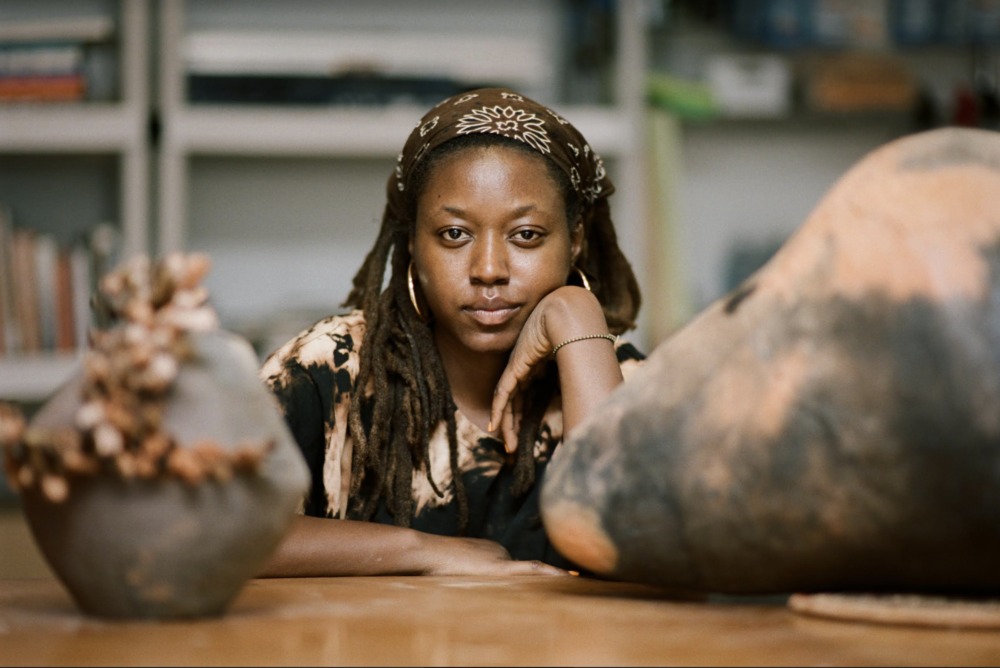
___
Adebunmi Gbadebo earned her BFA at the School of Visual Arts, NY, and a certification in Creative Place Keeping at the New Jersey Institute of Technology. Gbadebo’s works are held in the permanent collection of the Smithsonian National Museum of African Art, Smithsonian National Museum of African American History and Culture, the Minneapolis Institute of Art, the South Carolina State Museum, the Boston Museum of Fine Arts, the Newark Museum of Art, among others. Her work was recently featured in the Met Museum and MFA Boston’s exhibition Hear Me Now: The Black Potters of Old Edgefield, South Carolina.
Lara Xenia Mashayekh is an art writer with an interest in global modern and contemporary art. She holds a degree in art history from the University of St Andrews in Scotland and attends the Institute of Fine Arts at New York University.

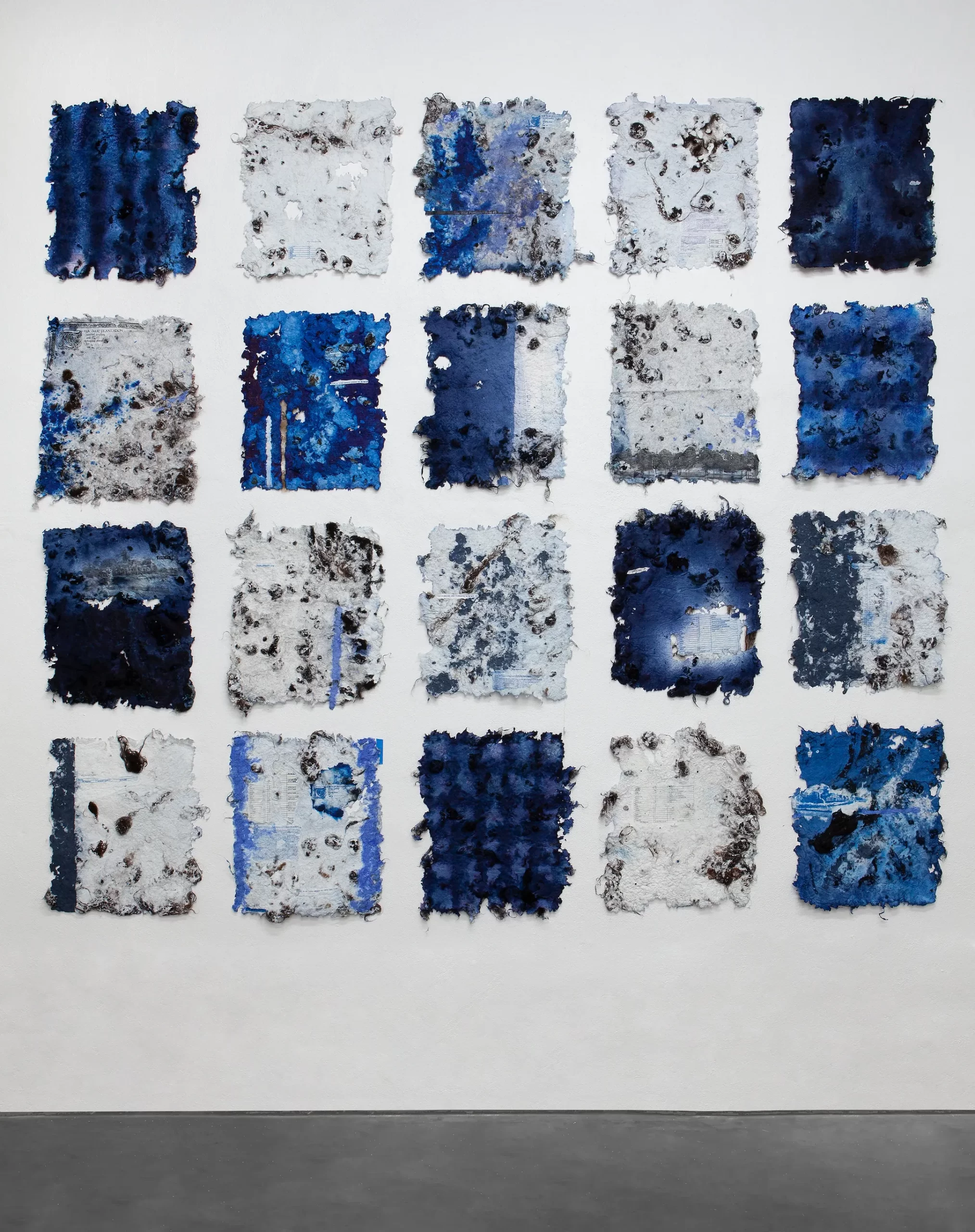
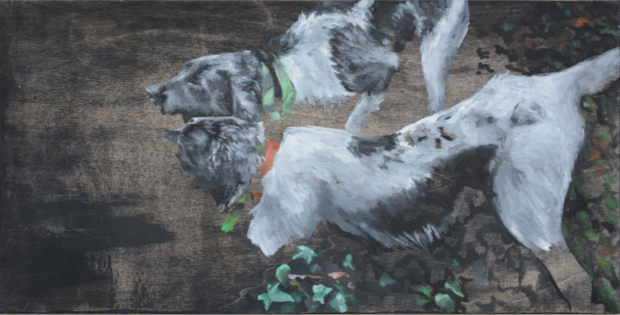
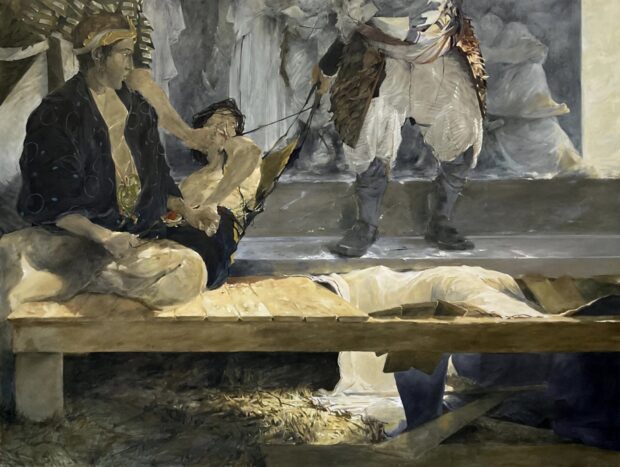
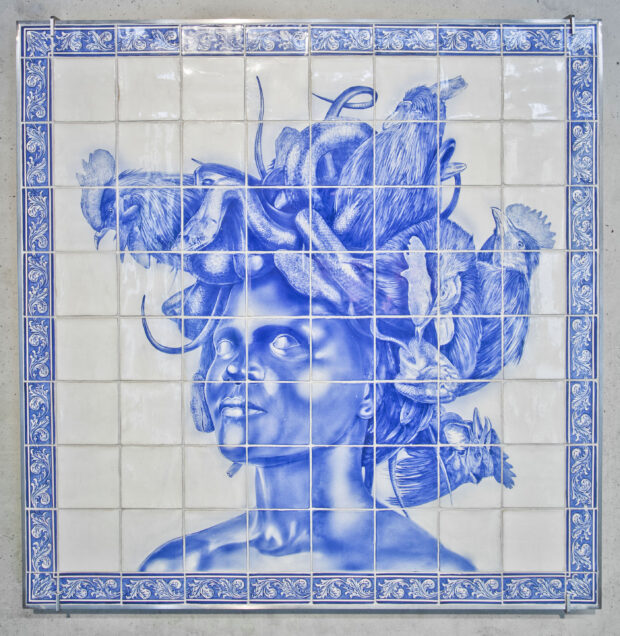

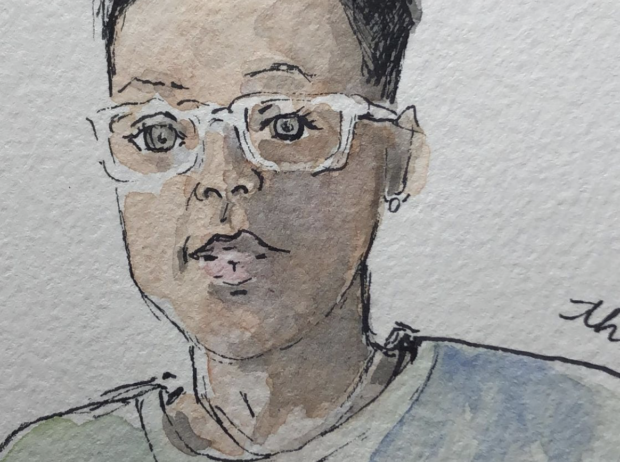
Be First to Comment